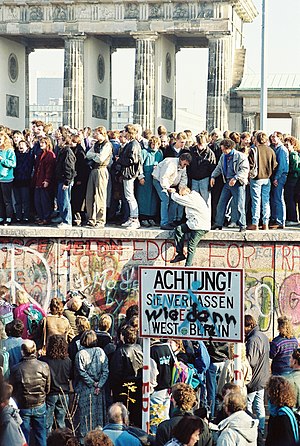| Peaceful Revolution | |||
|---|---|---|---|
| Die Wende Part of the Revolutions of 1989, the fall of the Berlin Wall and the Reunification of Germany | |||
 Berlin wall falls, Brandenburg Gate, 10 November 1989 | |||
| Date | 19 August 1989 – 3 October 1990 (1 year, 1 month and 2 weeks) | ||
| Location | |||
| Caused by |
| ||
| Goals |
| ||
| Methods | Civil disobedience, Civil resistance, Demonstration, Negotiations, Elections | ||
| Resulted in | Fall of the Berlin Wall (9 November 1989)Reunification of Germany (3 October 1990) | ||
| Parties | |||
| |||
| Lead figures | |||
The Peaceful Revolution (‹See Tfd›German: Friedliche Revolution) – also, in German called Die Wende (German pronunciation: [diː ˈvɛndə], "the turning point") – was one of the peaceful revolutions of 1989 at the peak of the collapse of the Eastern Bloc in the late 1980s. A process of sociopolitical change that led to, among other openings, the opening of their borders to the Western world.
These events were enabled by Soviet leader Mikhail Gorbachev's decision to abandon the Soviet sphere of influence and other shifts to the Soviet Union's foreign policy.
In East Germany—the former German Democratic Republic (GDR or DDR)—the peaceful revolution marks the end of the ruling by the Socialist Unity Party of Germany (SED) in 1989 and the transition to a parliamentary system. This peaceful transition later enabled the German reunification in October 1990. The peaceful revolution was marked by nonviolent initiatives and demonstrations.[1]
The GDR's lack of competitiveness in the global market economy, as well as its sharply rising national debt, hastened the destabilization of the SED's one-party state, similar to destabilization of such regimes in other Eastern Bloc countries.
- ^ Engler, Mark; Engler, Paul (2023-12-03). "From the Berlin Wall to Today — Lessons for Harnessing the Moment of the Whirlwind". The Commons Social Change Library. Retrieved 2024-09-14.